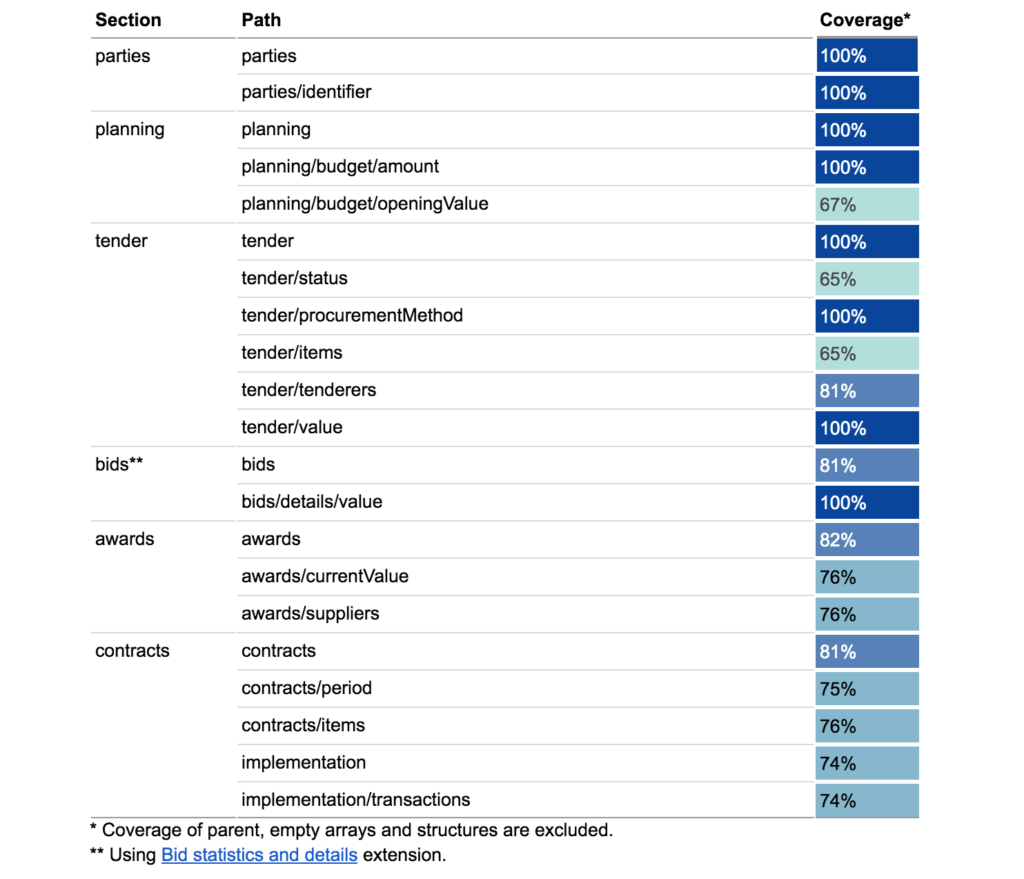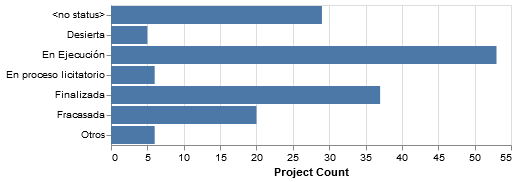A data review of the open data portal by Argentina’s road authority

In November 2019, Argentina’s Dirección Nacional de Vialidad (DNV), the national road authority in the Ministry of Transport, launched an data portal to publish information on all its contracting processes. This is the conclusion of a journey that started in 2018 with the help of the World Bank. Development Gateway was selected to carry out the project which included data publication and visualizations.
Since DNV’s work consists of public infrastructure projects, the information published includes data from both infrastructure projects and contracting processes. In this post, we will do a brief exploration of the published dataset and highlight its main features.
The data
The published dataset includes all contracting processes related to public works managed by the DNV between 2016 and 2019. Contracting processes and infrastructure projects have a clear one-to-one relationship in the data, meaning that a single contracting process is carried out for each project. Also, each contracting process is represented by a single release. As of 4 May, there are 156 releases (and projects) in the data. Technically a daily automatic update is possible.
We’ll start by looking at the following selection of the OCDS sections used, and the coverage for each one:

We can see that all of the OCDS stages are included and although we can’t show the complete list here, most of the fields of the OCDS core data are used as well. The coverage is high for most of the fields, although we do expect the latest stages (awards, contracts) to have less coverage due to an issue we’ll explain later.
The coverage shows there’s good availability of information, which is a good starting point for more detailed analysis. The figure below shows a few high-level graphs made using the data. A few features of the tender process always show the same values across releases (as Submission Method in the figure). This makes sense considering that all processes are about construction work, which can have specific requirements for the tender process like an open tender.
A set of local extensions has been used to provide data that does not fit within the OCDS core data. Most of the extensions have been created to provide project information (as we’ll see later), but there are two with a special purpose that deserve an explanation here. Due to the rising inflation in Argentina, prices change quickly and it is necessary to adjust monetary values from time to time. Adjustments are also needed when we need to compare values set in different times: for example, the same construction service can have a significantly higher value today than six months ago.
DNV provides inflation-adjusted values for some fields in the OCDS data using the following extensions:
- Opening value: adds the budget value adjusted to the bid opening date.
- Current value: adds the budget and award values adjusted to the current date.
Therefore, if we want to make summarizations of values, we need to use values to the current date, because they are adjusted to the same date. The figure below uses the award values adjusted to December 2019, to show the top 15 suppliers with total awarded values and total number of awards.

Both extensions include a field named coefficient that is calculated internally by the DNV and used to calculate the value to date. Since not every value in the data has been adjusted to inflation, we should be careful when using other values present in the data. Values to date and coefficients are updated each month.
The remaining local extensions are used to provide project information for each contracting process:
- Work Details: adds the current status of the project and project type (construction, rehabilitation, maintenance).
- Progress: adds the advance percentage for each project, and the investment and actual values.
- Certificates: adds information of the construction work certifications that are emitted through the execution phase of the project.
The figure below shows the values for the status field in the Work Details extension. Note that there is no status provided when the project is in the planning stage.

Even when the DNV makes a wide use of most of the fields in OCDS, there are a few details that can cause confusion to users that are familiar with the data standard. One example is that the items block in the tender section only contains the deliveryLocation block, from the Location extension, to include in the data the location in which the work is carried out. Another approach that could be easier to understand for users would be to create a local extension to put location data at release level.
Another possible improvement in the publication is to use the releases/records model. This can be particularly beneficial in the case of contract amendments, because even if amendments are provided, there is no way to track the changes made on each one.
Lastly, there are a few details that make it hard to track the current status of the contracting process. First, tags are not used correctly (most use the planning tag only when they are clearly ahead in the contracting process); second, empty lists and structures are not omitted from data (which is not necessarily an issue, but it does help to determine the stage of the process and to reduce the size of files); and third, some fields are filled way ahead in time, like contract titles when the data suggest the process is still in the planning stage. The last one causes the coverage to go down for some fields in the latest stages, as shown at the beginning of the blog post. Perhaps the tracking of the status of the contracting process has been disregarded in favor of the project status, but these may not be equivalent in all cases.
Summary
DNV makes good use of the fields provided by OCDS to publish their data, and using extensions (both existing and new) to provide details on the related projects. The use of adjusted values is particularly remarkable, as it enables users to make basic calculations and comparisons that would be very hard to do without.
It is important to mention that DNV started working in their open data portal before the launching of OC4IDS. OC4IDS is a data standard developed with CoST, designed to disclose projects and their related contracting data. Using OCDS only for project data disclosure has some limitations: for example, the DNV associates each project to a single contracting process, while an infrastructure project may have many contracting processes associated with it. As you have seen here, it also make it necessary to use extensions (as Location) to fully cover project data. In future updates, we recommend exploring OC4IDS to improve modeling potential one-to-many relations and increase the detail of project-related coverage within the data.
This work is a great first step to disclose infrastructure data in the region. We hope to continue supporting their commitment with public work data disclosure, as is stated in Argentina’s Government last OGP Action Plan (Compromiso #4); as well as the continuous update of the data in a timely manner. Are you interested in analyzing infrastructure project data? Have a try with this dataset. Go to the portal and look for the CSV and JSON links in the top right of the page. If you have any questions or comments about OCDS and OC4IDS, or if you want to share your experience with DNV data, please contact us, we’d love to hear from you!